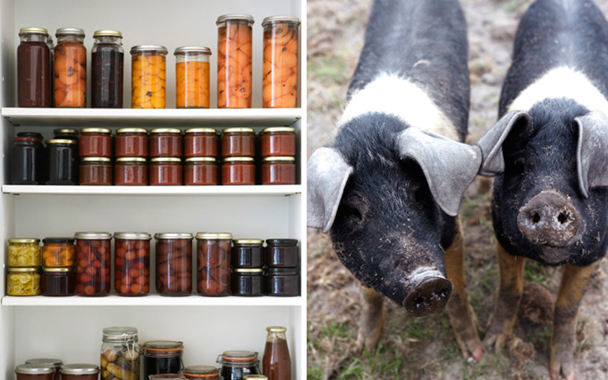Pigs (and, specifically, the eating of pigs) are of great interest these days, whether in the form of jamón ibérico de bellota or hickory-smoked pulled pork. So it should come as no surprise that The Agrarian Kitchen, which is setting new standards for paddock-to-plate cooking schools, lists among its programs a two-day course encompassing everything from breaking down the freshly killed beast to transforming the resulting cuts into a porcine feast.
For the aptly titled “Whole Hog” course, a free-range, organically raised Wessex Saddleback is dispatched to an abattoir near The Agrarian Kitchen’s property, outside Hobart, in Tasmania. The class begins with chef and owner Rodney Dunn and local butcher and pig breeder Lee Christmas demonstrating how to break down half the carcass into prime cuts (the two men arrange for the killing and scalding beforehand), after which students do likewise with the other half. The belly goes straight into the wood-fired oven (designed, incidentally, by the recently deceased Alan Scott, the Australian-born brick-oven guru whose work can be seen in bakeries all over the United States) to roast slowly for lunch with vegetables from the garden. “The head,” says Dunn, who trained at Sydney’s famous Tetsuya’s Restaurant, “goes into brine for a terrine. Most of the rest of the first day is learning the cuts and prepping them for the second day.”
Day two is all cooking. Depending on the weather and everyone’s mood, that could involve making sausages; rendering lard for whipping and serving on bread à la Italian “butter”; stuffing trotters; slow-cooking the ribs; and simmering other bits and pieces with cassia and soy to make a broth topped with Lincoln peas, mint, cilantro, and pork cracklings. You’re dealing, in short, with pretty much every part of the pig.
“We’re growing most of the stuff we’re cooking with, and having it so close makes a real difference to the experience, as well as to the quality of the food,” says Dunn. “With the animals, too, we’re trying to replicate the way small farms used to be, trying to be self-sufficient and trading with other local farms. We want to teach classes that are a bit different, a bit back-to-the-land.”
Still, the school isn’t all pig all the time. The basic one-day class has students picking fruits and vegetables in the morning to pair with other local ingredients in dishes such as a forager’s salad of ten different lettuces and chive flowers; a chickpea soffritto; a rotolo of prosciutto, ricotta, and Swiss chard with rosemary butter; pork neck braised in milk (okay, so pork is rarely far from the menu); and a Meyer lemon and wild elderflower cordial with black-currant-leaf ice cream. “Agrarian Master Classes” are dedicated to specific artisanal techniques—butter and cheese, bread baking, ice cream, preserving, and the like—while “The Bespoke Agrarian” features tailor-made classes. (011-61-3-6261-1099; theagrariankitchen.com; “The Whole Hog” weekends, $443, take place every other month.)
Snout-to-Tail Cookery
Here are a few schools in North America that offer courses in pork preparation: The Brooklyn Kitchen (thebrooklynkitchen.com), Brooklyn, New York; Dai Due (daidueaustin.com), Austin, Texas; and The Healthy Butcher (thehealthybutcher.com), Toronto.


